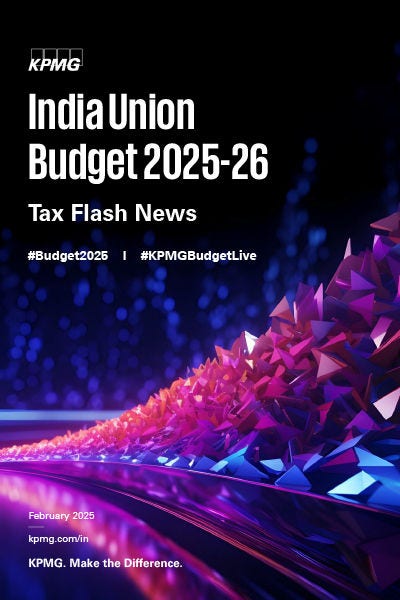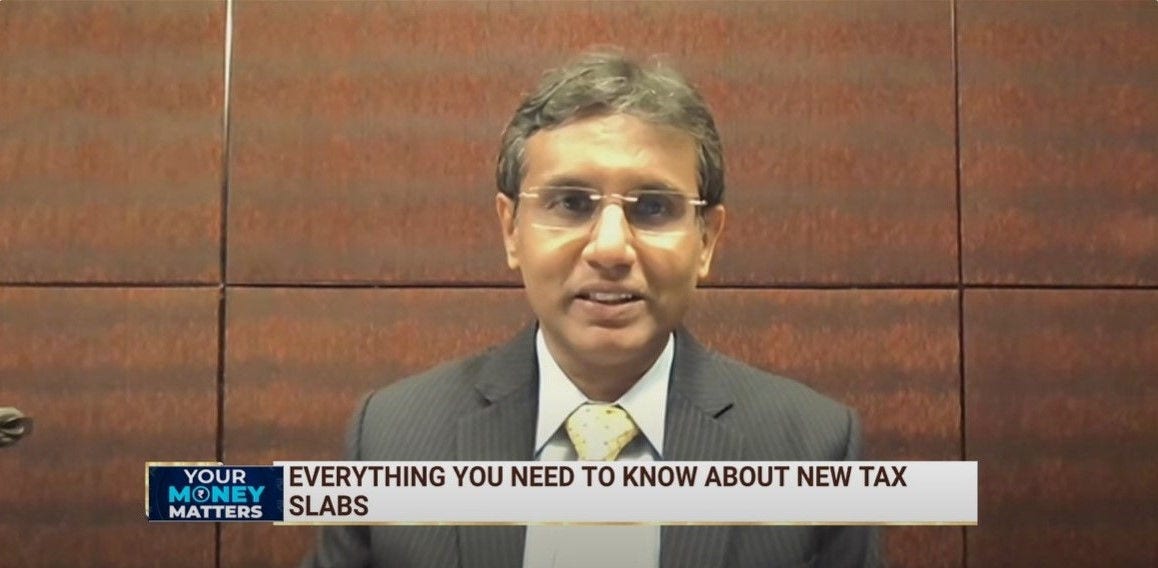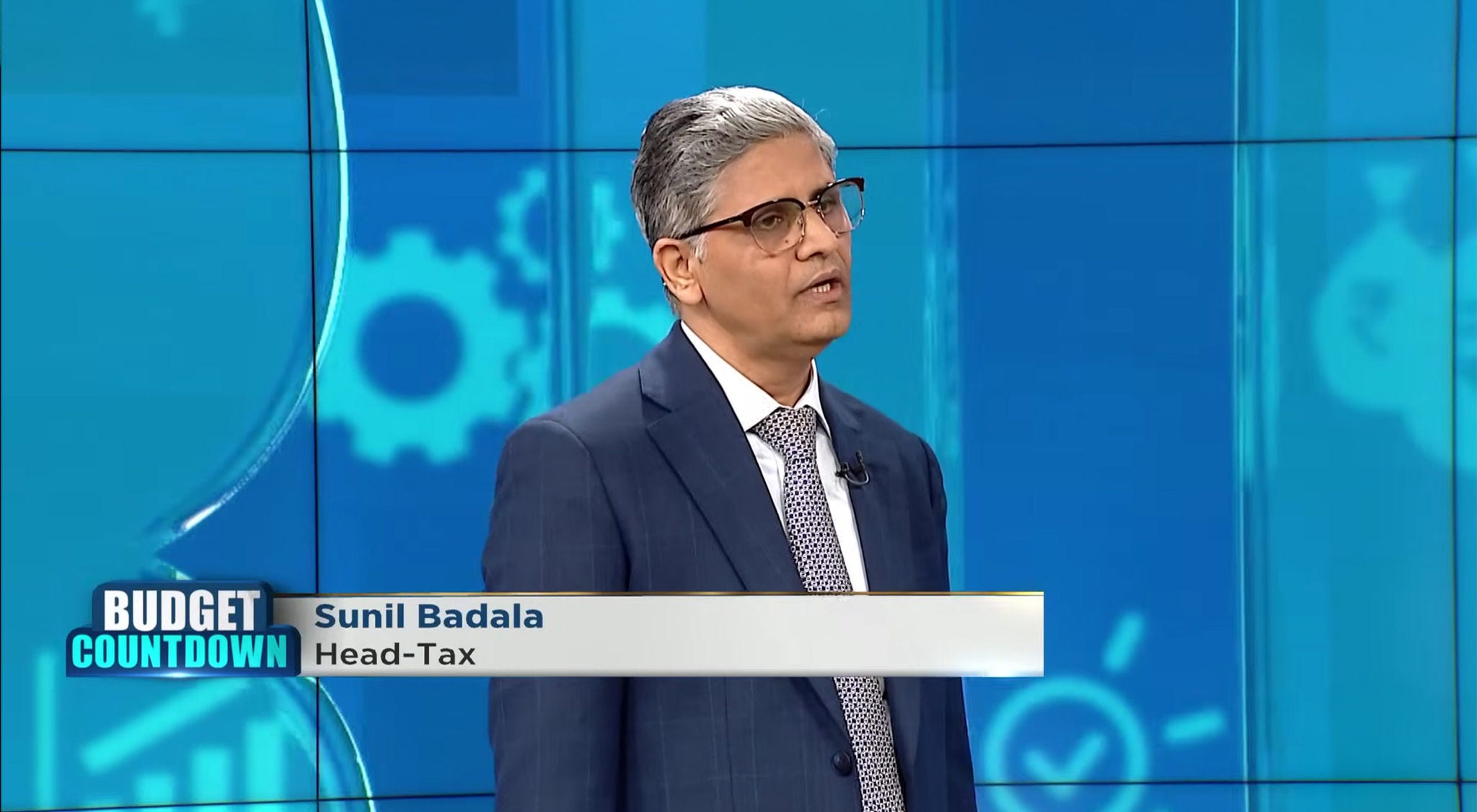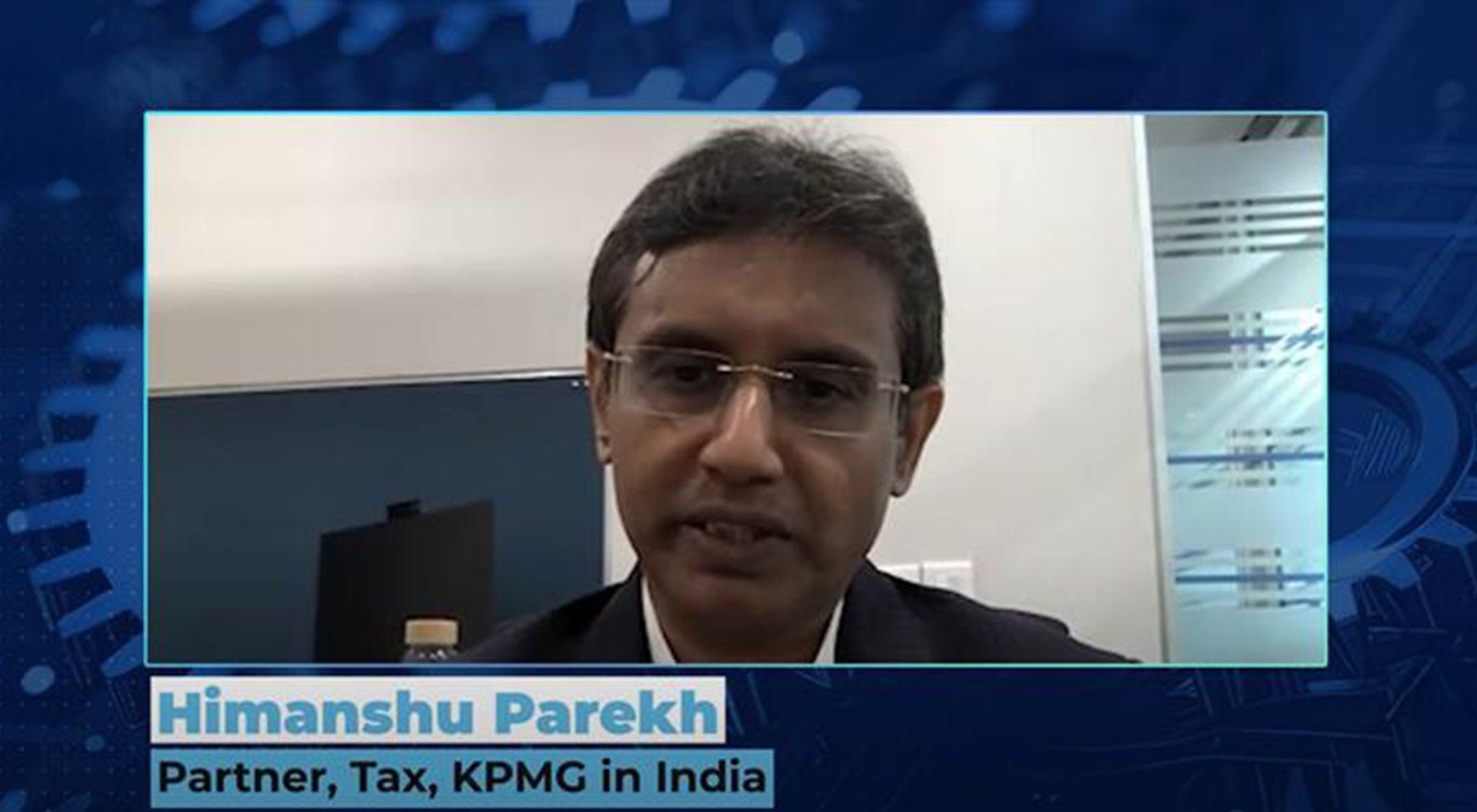KPMG in India conducted an online survey to understand industry views and expectations from the simplification exercise
Income-tax Bill, 2025
The Bill seeks to simplify the legislation by consolidating similar provisions, eliminating obsolete sections, and presenting some information in a tabular format
India Union Budget 2025-26 highlights
In today’s Union Budget 2025, the finance minister outlined a series of key proposals aimed at shaping India’s economic future. From tax reforms to investment in infrastructure, digitalisation, and social welfare, the budget highlights several transformative initiatives designed to stimulate growth, enhance inclusivity, and drive sustainability.
The finance minister announced that a new Income-tax bill would be introduced in the next week, with close to half of the present law, in terms of both chapters and words. The finance minister also mentioned that the bill will be simple to understand for taxpayers and tax administration, leading to tax certainty and reduced litigation.
On the personal tax front, tax slabs and rebates have been amended under the default (new tax) regime. As a result, there would be no income tax payable up to the income of INR 12 lakh (other than income taxable at special rate such as capital gains).
The domestic taxation proposals include an extension of the sunset clause for incorporation of an eligible start-up to claim tax holiday and inclusion of the inland vessels in the existing tonnage tax regime. The threshold limits for applying the TDS provisions are proposed to be increased to ensure that low-value transactions are not subjected to TDS compliance.
A new presumptive tax regime is introduced for non-residents providing technology or services to support the setting up of electronics manufacturing facilities in India. The activities confined to the purchase of goods from India are now excluded from the purview of significant economic presence (SEP) provisions bringing it in line with the business connection provisions.
The corporate tax rates remain unchanged. However, the budget does not address the expected implementation of the Organisation for Economic Co-operation and Development's (OECD) global minimum tax (GloBE rules) in India.
The government's recent proposals aim to boost the financial and insurance sectors in India by attracting more international capital and enhancing investment opportunities. By raising the Foreign Direct Investment (FDI) limit in insurance to 100 per cent, the government seeks to increase insurance penetration and bring in more global players, subject to certain conditions. This move is expected to enhance the competitiveness and efficiency of the insurance sector.
The International Financial Services Centre (IFSC) is gaining global traction as a prime destination for financial activities. Key policy changes include expanding the scope of aircraft leasing to include ship leasing, extending sunset dates for various IFSC units, and rationalising the definition of 'dividend' for treasury centers. Additionally, a simplified regime for fund managers based in IFSC and exemptions for non-residents from offshore derivatives instruments issued by Foreign Portfolio Investors (FPIs) located in IFSC are being introduced. The inclusion of retail schemes and Exchange-Traded Funds (ETFs) in the tax-neutral relocation regime further enhances the attractiveness of IFSC.
Recognising the long-term nature of infrastructure investments, the finance minister has proposed extending the deadline for investments in specified infrastructure sectors by five years, until March 31, 2030. This extension aims to provide stability and a clear timeframe for global investors, particularly Sovereign Wealth Funds (SWFs) and Pension Funds (PFs), to contribute significantly to India's infrastructure development. These measures collectively aim to strengthen India's financial landscape and foster sustainable economic growth.
The proposals for rationalisation of various TDS and TCS provisions are aimed to provide enhanced cash flow for various individuals – including even senior citizens. More emphasis has been laid on ‘trust first, scrutinise later’ by increasing the time limit for filing updated tax returns. In an effort towards simplified tax legislation, new tax bill is proposed to be introduced in the coming week.
The transfer pricing audits, or assessment have been rationalised in line with international leading practices. With effect from assessment year (AY) 2026-27, the taxpayers will have an option to choose whether they wish to apply the outcome of transfer pricing assessment order of current year under assessment (i.e. the ongoing proceedings) to the following two years. To exercise this option, the taxpayers will be required to make an application in a manner which will be clarified in the rules, and the Transfer Pricing Officer (TPO) will have to convey his acceptance within a month. Once it is validated by the TPO, the same outcome of arm’s length price will apply to all three years for the chosen or similar transactions. This appears to be a step in the right direction, as it will curtail the time, efforts, and resources that are invested in repetitive assessments of similar transactions year after year.
The government has also proposed to expand the application of safe harbour rules, details of which will be released later by way of a notification.
The Union Budget 2025-2026 continues to focus on the ‘Make in India, Make for the World’ initiative, with specific assistance to industries such as toys, leather, food processing, electric vehicles, and electronics through customs tariff rationalisation.
Further, some more significant changes in customs include establishing clear timelines for finalising provisional assessments and permitting voluntary rectification of errors without penalties.
On the GST front, as expected, all the GST law amendments as recommended by the GST council have been introduced in the budget.
India Union Budget 2025-26 highlights
The publication highlights the salient features of the Finance Bill, 2025 with respect to tax and indirect tax proposals.

KPMG in India leaders on Union Budget 2025-26
- Yezdi Nagporewalla
- Sunil Badala
- Himanshu Parekh
- Parizad Sirwalla
- Gaurav Mehndiratta
- Kalpesh Maroo
- Abhishek Jain
- Anish De
- Neeraj Bansal
- Nikhil Sethi
- Namrata Rana
- Atul Gupta
- Nilachal Mishra
- Vishnu Pillai
- Manoj Kumar Vijai
- Vivek Agarwal
- Mohit Bhasin
- Vikas Gaba
- Kailash Mittal
- Dr. Puneet Mansukhani
- Supreet Sachdev
- S Sathish
- Prasanth Shanthakumaran
- Chintan Patel
- Anvesha Thakker
- Amit Bhargava
- Naveen Aggarwal
- Anshul Aggarwal
- Prashant Kapoor
- Vikram Srinivas
- Vinay Narkar
- Nirmal Nagda
- Kalpesh Desai
- Gautham Lokande
- Somdeb Sengupta
The Union Budget 2025 is a visionary and inclusive blueprint for India's economic ascent, setting the stage for Viksit Bharat, ready to lead in the global arena. The government's commitment to reducing the fiscal deficit to 4.4% while laying down robust economic foundations for growth of the economy is truly commendable. The emphasis on skilling initiatives, particularly through the establishment of 50,000 Atal Tinkering Labs and the Centre of Excellence in AI, will empower our youth with the skills needed to excel in a digital economy.
Moreover, the inclusive measures aimed at supporting the startup ecosystem, women entrepreneurship and rural prosperity, underscore a balanced and equitable approach to development. Strategic initiatives to boost trade and exports, such as the Export Promotion Mission, and BharatTradeNet, the digital public infrastructure for seamless trade documentation and financing, complemented by the Unified Logistics Platform, will significantly enhance the competitiveness of Indian businesses on the international stage.
The proposed introduction of the new Income Tax Bill, which will considerably simplify the existing Income Tax Act, is a much awaited and a landmark move towards simplified tax regime, further fostering a conducive environment for growth and innovation. Also, personal income tax reforms like significantly enhancing the income-tax exemption limit will provide a much needed boost to the middle class and an impetus to economy through additional disposable income available to consumers, additionally, rationalisation of TDS/TCS regime will ease the compliance burden of taxpayers.
Recognising tax as one of the six wheels of transformation towards 'Viksit Bharat 2047', this budget highlights the government's commitment to economic growth. All expectations highlighted by KPMG’s industry-wide survey seem to have been catered to in this budget especially rationalisation of TDS/TCS provisions, simplification of laws for tax certainty, reforms for reduced tax litigation and the timeline for release of the new Direct Tax Bill.
In line with the Economic Survey, this budget aims to position India as a global business hub by encouraging foreign investments with targeted tax benefits and a streamlined regulatory environment.
Key initiatives include revamped KYC processes, a light-touch regulatory framework, and reforms in transfer pricing and safe harbour rules with a focus on enhancing ease of doing business. Notable tax reforms include an increase in personal income tax thresholds & slab-wise reduction in rates, extended tax benefits for certain IFSC units, allowance of 100% FDI in the insurance sector with certain conditions and launch of a fund of funds for startups. The budget also focuses on inclusive growth, offering major tax breaks to the middle class, encouraging them to opt for new tax regime, to senior citizens, startups, and MSMEs, while boosting foreign investments.
The Union Budget 2025 is forward-looking focusing on agricultural growth, MSME support, education, healthcare, and infrastructure development. It proposes financial sector reforms and personal income tax changes to enhance the attractiveness of the investment landscape and provide boost to middle-class consumption power.
Hon'ble FM has provided multiple reliefs to tax payers at large under the new tax regime with revamped tax slabs and full tax rebates for normal income (excluding capital gains) up to INR 12 lakh. Senior citizens and individual taxpayers making foreign remittances (including for education purposes) get a cash flow boost by way of rationalised TDS/ TCS provisions. The New Income Tax Bill proposed next week will aim for simplicity and reduced litigation. Additional measures are introduced for specific target groups - social security measures for gig workers and certain foreign tourists get visa fee waiver. A Budget with specific focus on middle class.
Overall defence budget witnesses a 10% increase with an allocation of INR 6.8 lakh crore (USD 79 bn). However, capex allocation at INR 1.8 lakh crore (USD 21 bn) gets a modest 5% increase against the budget estimate of 2024, and 13 per cent increase against the revised estimate of 2024. For the modernisation and ‘Atmanirbharta’ vision capex budget misses expectations.
Largely a wait and watch budget from a deals and private equity point of view. 5 year extensions for SWF / Pension funds for infrastructure investments, clarity on income classification for AIFs, proposed expansion and simplification of fast-track mergers and abolition of TCS on share transfers are all positive. Lots to watch out for next week on the promised new, improved and simplified tax code.
Budget 2025 maintained its emphasis on the “MakeinIndia, Make for the World” initiative. Various schemes aimed at enhancing infrastructure and business-friendly policies are expected to strengthen India’s position as a global hub for industries such as toys and leather. Measures to support shipbuilding, including financial assistance and duty rationalisation, will further drive growth in this sector. Additionally, adjustments to customs duties, particularly in emerging and sustainable industries like electricvehicles and electronics, are set to foster expansion and development in these areas.
The ambitious program on nuclear power outlined in the Budget 2025 is a very welcome development. In the coming decades the country will become the second largest energy demand centre in the world. Nuclear energy will have to play a central role in decarbonisation of India's energy supplies. For this a range of issues have to be addressed including on technology, fuel, safety, liabilities and costs. Setting a clear north star on development of nuclear power at scale through the Union Budget provides directional clarity on these issues. However a string of follow on measures will be required to ensure implementation of the goals and attract. Amendment of the Atomic Energy Act will be a key step in that regard.
Budget2025 lays the groundwork for a future-ready economy by strengthening India’s manufacturing, exports and innovation ecosystem. With strategic investments in infrastructure, clean tech and INR20,000 crore for deep tech, alongside tax rationalisation and trade facilitation, the Budget sets the stage for sustained growth and global competitiveness.
The Budget2025 continues to prioritise basic consumption through employment guarantee schemes, direct benefits, and subsidies. Key initiatives like the PM Dhan Dhaanya Krishi Yojana and the Rural Prosperity Program aim to enhance agricultural productivity and improve rural economies, thereby boosting demand in tier 2 and 3 regions. The focus on increasing credit availability and support for farmers, women, and youth is expected to reduce migration and enhance rural livelihoods.
In addition, the budget takes significant steps to stimulate consumption by attracting long-term investments and reducing the tax burden in the short term. Measures such as the increase in the farmer credit card limit, customised credit cards for micro-enterprises, and the National Manufacturing Mission are designed to create employment and increase spending. The enhancement of the MSME classification limits and the boost to sectors like toys, footwear, and leather manufacturing are expected to drive local production and meet rising consumer demand.
Overall, the Budget 2025 aims to balance immediate consumption needs with long-term economic growth by fostering investment and reducing tax liabilities, thereby creating a more robust and inclusive economy.
The Budget 2025 boosts rural and urban economies through enhanced agricultural productivity, increased credit availability, and reduced tax burdens, fostering investment and consumption for a more inclusive economic growth.
India’s Union Budget 2025 takes big strides in ESG with a focus on sustainable growth! From a major focus on driving sustainable livelihoods, climate-resilient farming, building the critical minerals mission and renewable energy invigoration— sustainability is at the core. A step towards a greener, more inclusive future!
Budget 2025 enables INDIA to progress forward with a decisive focus on clean energy, manufacturing, education, disposable income, healthcare and MSMEs.
The budget also provides a good platform to bring mass innovation carried out at the Indian grassroots to the mainstream by establishing 50k ATL Labs, which will position the country in new innovative solutions across emerging areas AI, Cyber, Data, ESG, Fin Tech, Space Tech.
Nilachal Mishra
Partner and Head, Government & Public Services (G&PS), National Leader - Government and Infrastructure
KPMG in India
The Union Budget 2025-26 underscores a decisive push towards strengthening India's agricultural sector and ensuring economic resilience. Initiatives like Prime Minister Dhan Dhanya Krishi Yojana will enhance productivity in low-output districts, directly benefiting 1.7 crore farmers with improved access to credit, crop diversification, and post-harvest infrastructure. The expansion of the Kisan Credit Card (KCC) scheme, with an increased loan limit, will further support farmers, fishermen, and dairy farmers in meeting their financial needs.
The emphasis on high-yielding, climate-resilient seeds through missions like the Cotton Productivity Mission and National Mission for High-Yielding Seeds signals a forward-thinking approach to boosting self-sufficiency. Similarly, the Aatmanirbharta in Pulses Mission is a timely response to global challenges around food security, promising enhanced farmer incomes through better storage and pricing mechanisms. By integrating research and commercialisation with farmer needs, these initiatives offer a much-needed shift from traditional agricultural practices to innovation-driven growth.
In parallel, the push for rural entrepreneurship, through support for cooperatives and MSMEs, alongside the strategic repositioning of India Post, offers a comprehensive approach to strengthening rural economies. Additionally, upgrades in infrastructure, including fisheries, air cargo, and logistics, will unlock potential in key sectors.
These measures collectively lay the foundation for an inclusive, resilient, and sustainable agricultural sector, propelling India towards a self-reliant future.
Budget 2025, presented by the Hon'ble Finance Minister today is another step towards pushing growth with a focus on MSMEs and manufacturing, reducing the deficit and promoting inclusiveness through huge improvement in personal income tax slabs - in aid of the development agenda for the nation.
The Union Budget 2025-26 strikes a balance between fiscal prudence and growth ambition. With tax relief for the middle class, higher FDI in insurance, and incentives for manufacturing, energy, and tourism, it sets the stage for a resilient and future-ready economy.
Vivek Agarwal
Partner and Head - Public Infrastucture, Lead - Industrial and Infrastructure Development Advisory, Government and Public Services
KPMG in India
Union Budget 2025 paves the way for Viksit Bharat 2047 with reforms-driven growth. It boosts consumption while prioritising infrastructure in maritime, air connectivity, urban development, and energy. Stronger PPP adoption signals greater private participation. Tax reforms, FDI in insurance and investments in AI-driven human capital, indicate broad-based economic progress.
Budget 2025 has laid special focus on manufacturing-led hashtag economic growth. Sectors such as footwear & leather, toys, food processing are given special emphasis for growth of domestic manufacturing and creating jobs. National Manufacturing Mission(NMM) covering small, medium and large industries will amplify “MakeinIndia” by providing policy support, execution roadmaps, governance and monitoring framework for central ministries and states.
The Budget 2025 continues the momentum set in the previous year, focusing on cleantech manufacturing, nuclearenergy, electricitydistribution reforms, and intra-state capacity expansion. A new mission for clean-tech manufacturing covering solar PV cells, electrolysers, EV batteries, and high-voltage transmission equipment will accelerate India’s path to Atmanirbharta, The push for nuclear energy remains strong, with a 100 GW target by 2047 and a 20,000 Cr R&D mission for Small Modular Reactors (SMRs), alongside necessary legal reforms and promotion of private participation. SMRs offer a scalable, cost-effective, and safer path for energy transition and can be a game changer in the long-run. Distribution reforms and intra-state capacity augmentation also receive a boost, with additional financial incentives tied to their implementation.
Increasing the FDI limit from 74% to 100%, with an indication towards revisiting extant conditions around FDI, will attract foreign insurers. While we wait for the fine print, investing 100% of premiums in India benefits all stakeholders and is not at all a deterrent.
Additionally, making proceeds of all insurance policies, issued by IFSC insurance offices, tax free at maturity under Section 10(10D); will boost new business from these offices.
Dr. Puneet Mansukhani
National Sector Head - Retail, Global Retail Head - Digital & Technology Transformation
KPMG in India
The retail sector expected strong support from this year’s budget, and key measures are set to drive sustained growth. Higher income tax exemptions will increase disposable income, leading to greater consumer spending. The government’s plan to make India a global hub for footwear and leather manufacturing will boost domestic production and exports.
Agricultural benefits will enhance retail penetration in Tier 2 and Tier 3 markets by improving rural incomes and purchasing power. Additionally, expanded skill development programmes will create jobs in the retail front-end sector, further driving sales. The toy industry will also see major gains as India is positioned as a global delivery hub, fostering manufacturing and exports.
With increased infrastructure spending, supply chains will improve, reducing logistical inefficiencies and supporting retail expansion. Overall, the budget prioritises ease of doing business, job creation, and consumer spending, laying a strong foundation for long-term retail growth and global competitiveness.
Aligned with the vision of Viksit Bharat 2047, this Budget reinforces Government’s commitment to economic growth and innovation. While the Budget provides relief for middle class taxpayers, it equally seeks to maintain fiscal balance. The announcements made also reflect a sincere attempt to promote ease of doing business in India and continued focus on the MSME sector. Other significant policy changes include allowing 100% foreign investment in insurance sector. On an overall basis, there seems to be shift from investment/ capex based growth model to a consumption led model.
The Budget 2025 is clearly a “Make in India” enabling budget aimed to trigger manufacturing activity to the next level and also strengthen the key enablers that can complement the manufacturing sector growth. The key announcements on the national manufacturing mission, domestic capacity building for global supply chain integration, focus on electronic / battery manufacturing, customs exemption for critical materials, Centers of Excellence for skill building and enhanced credit limits for MSMEs will ensure that India rises in ranks as most favoured nation for manufacturing to tap the global opportunities.
Sports has got good impetus in the current budget with a 10 per cent increase in overall allocation and a 25 per cent increase in the Khelo India program to drive grassroots adoption. By investing in sports & fitness in a significant way, the healthcare budget can be pruned over time.
Chintan Patel
Partner - Deal Advisory, Transport & Logistics, Head - Real Estate & Hospitality
KPMG in India
SWAMIH Fund 2 is a much-welcome step from the Hon'ble Finance Minister and will definitely help complete a number of stranded projects. SWAMIH Fund 1 was a big success and helped a large number of affordable and mid-income homebuyers whose projects were stalled due to lack of fund
Budget 2025 delivers a decisive push for clean energy, emphasising the key pillars of “Make, Innovate, and Expand.” By strengthening supply chains, accelerating AI and deep tech, and unlocking the potential of nuclear energy, it takes bold steps to not only make India self sufficient but also establish it as a global leader in the clean energy sector.
Budget 2025 has recognised and empowered the aspirations of the metals and mining sector to further strengthen its global positioning, in terms of scale of production, greener product offerings and increased innovation. The budget supports specifically in realising mining potential, availability of digital capabilities, increasing value chain competitiveness, enabling energy transition and decarbonisation, encouraging critical minerals related circularity and logistics efficiency.
Some of the key takeaways are:
- Minor minerals mining and critical minerals recovery from tailings is a step to realise the potential of mining and availability of critical minerals (including exemption/ reduction of BCD on key critical minerals)
- Empowering MSMEs to enhance exports, access to technology and funding would be a step toward improving the competitiveness of the sector’s downstream value chain
- Clean technology focus that helps establish domestic solar/EV-related manufacturing would be critical in further expediting the energy transition of the sector
- Centre of Excellence for AI and emphasis on Industry 4.0 would be instrumental in ensuring the availability of key digital capabilities, so critically required by the sector
- India post infrastructure to be leveraged in bringing in greater logistics efficiencies

Naveen Aggarwal
Office Managing Partner - Delhi NCR | India Global - U.S. Corridor Leader
KPMG in India
Budget 2025 focuses on fueling domestic demand-led growth, prioritising infrastructure, jobs, and social welfare to boost economic expansion, with strategic investments and policy initiatives driving India's development and resilience narrative in an uncertain global environment.

Anshul Aggarwal
Partner, Indirect Tax
KPMG in India
Optically, the Budget 2025 comes at an hour when the world is witnessing an overall economic slowdown, given that, the announcements made by the FM are focused on boosting manufacturing and offering higher disposable income in the hands of individual taxpayers. Bringing in a fresh influx of funds for startups gets a thumbs up and the effectiveness of the new social security norms for online platform gig workers would be critical to watch for.

Prashant Kapoor
Leader, India - Europe Corridor
KPMG in India
Budget 2025 shows India’s commitment to provide tax certainty and a simplified tax environment for international businesses and foreign investors. The rationalisation of “Significant Economic Presence (SEP)” provisions, exempting Non-resident Indians engaged in export-oriented purchases as well as the allowance of 3-year applicability of same arms length pricing for continuing transfer pricing transactions, are measures to reduce litigation and enhance ease of doing business in India. Multinational enterprises intending to invest or scale their presence in India will also benefit from the government’s proposal to revamp KYC processes, introduce a light touch regulatory framework and intent to align with global best practices.

Vikram Srinivas
Office Managing Partner - Chennai
Targeted proposals to help MSMEs, be it the enhanced credit guarantee schemes, MSME credit cards, Bharat Trade Net should help unlock the next round of growth, exports and employment generation in this segment and by extension, drive growth for all banks and NBFCs focused on this space!
Separately, am quite thrilled to see the Government’s sustained focus on decluttering laws and enhancing ease of doing business, including the proposed measures to widen the scope of fast-track mergers.

Vinay Narkar
Partner - Transformation, Financial Services Advisory
KPMG in India
MSME
Increasing the guarantee cover to INR 10 crore from INR 5 crore for micro and small enterprises (MSME) will enable these enterprises who face issues in providing collateral for these loans to access credit from Banks due to the increased guarantee scheme limit.
KYC
Roll out of revamped CERSAI platform in 2025 will significantly reduce the KYC costs for onboarding new customers and periodic updates for existing customers for banks and NBFCs. This revamped platform will in turn help in easier and upto date access of KYC information of customers removing the data quality challenges in current CERSAI platform.

Nirmal Nagda
Partner, Deal Advisory - M&A and PE Tax
KPMG in India
The extension of SWFs and PFs exemptions for infrastructure investments till 2030 is a bold and welcome move that provides long-term clarity for investments in this all-important sector. Policy continuity and clarity are what this investor class was looking for.
Kalpesh Desai
Partner, Deal Advisory - M&A Tax
KPMG in India
Largely a wait and watch budget from a deals and private equity point of view. 5 year extensions for SWF / Pension funds for infrastructure investments, clarity on income classification for AIFs, proposed expansion and simplification of fast-track mergers and abolition of TCS on share transfers are all positive. Lots to watch out for next week on the promised new, improved and simplified tax code.
Gautham Lokande
Partner, Deal Advisory - M&A/PE Tax
KPMG in India
Budget 2025 is expected to trigger new opportunities for the real estate sector. Reduction in personal taxes, being the hero announcement of Budget 2025, enhances liquidity for taxpayers and can prompt investments in new homes. At the macro level, the overall momentum in urban growth is set to continue with the setting up of the Urban Challenge Fund and the second fund for reviving stressed affordable housing projects.
Somdeb Sengupta
Partner, Financial Risk Management
KPMG in India
MSME: New investment and turnover limit enhancement for the MSME sector as well as the credit guarantee scheme will have a significant impact on credit growth in the financial services sector. Banks and NBFCs will see a spike in demand for last mile financing.
- The MSME sector contributes significantly to India’s exports. The proposed digital public infrastructure (DPI) for trade documentation and financing solutions will also result in increased demand for trade finance products and export credits.
- Agri financing: Loan limit enhancement under the modified interest subvention scheme for loans taken through the KCC will see increased credit demand in this sector. Initiatives outlined under Prime Minister Krishi Yojana for the agricultural sector should ensure sustainable growth for the sector, aided by affordable short-term and long-term financing options.
Our Sector Insights
Hear from the experts
- Budget Analysis and Impact Videos
- Pre-Budget Expectations
Our Latest Thinking
- India Union Budget 2025-26
- Pre-Budget
- Direct Tax
- Banking, Financial Services and Insurance
- Global Mobility Services
- Transfer Pricing
- Indirect Tax
This being the first full budget for the new Government there will always be a slew of expectations from a personal tax perspective. However, one has to also bear in mind the current state of economic growth for India, global economic indicators and other factors that the finance minister will consider before presenting the personal tax proposals. Also, the Government has set-up a separate committee for a comprehensive review of the income tax law from a simplification and ease of administration and compliance perspective.
In that backdrop, some of key expectations are outlined below
- Providing impetus to the housing sector
- Hike in deduction towards health insurance under section 80D
- Potentially stable income slab and tax rates
- Other procedural amendments
In line with the objective of the Government of Housing for all, it is widely expected that the Government may consider some tax sops for the housing and funding cost for the middle and low income earners. In the context of a self-occupied property, the new default tax regime disallows any deduction for interest on housing loans. Conversely, the old tax regime permits a deduction of up to only INR2 lakhs. This distinction is crucial as buying a home and securing a loan for self-occupation are substantial financial commitments, often spanning long periods. With recent hikes in interest rates and regulatory reforms there is mounting pressure on the real estate sector. To alleviate these challenges and foster home ownership, it is suggested that the Government may reconsider allowing deductions for interest on self-occupied housing loans even under the new default tax regime or enhancing the deduction in the old tax regime to at least INR3 lakhs.
With advancement in healthcare and spiraling medical costs, there is an expectation to increase the current deduction towards health insurance which ranges from INR25 thousand to INR1 lakh (depending on the family member for whom the insurance is taken and his/her age) to INR50 thousand to INR1.5 lakh.
Over the last three-four years the Government has made a conscious effort to make the income slabs and corresponding tax rates more lucrative for taxpayers opting for the new tax regime. Infact the new tax regime tax slabs have been altered in Budget 2023 as well as interim Budget of 2024 as well. This thrust has yielded results as per the statistics released by the Government itself. As per the said statistics for the assessment year 2024-25 (FY 23-24) 72 per cent of taxpayers opted for the new tax regime compared to 28 per cent who chose the old tax regime.
Hence, while there is always expectation from the common man to get more net disposable income in their hands, on a realistic basis it is expected that there may be no changes to the income slabs and tax rates in the old tax regime and minimal changes (if any) in the new tax regime.
Infact, basis the larger agenda of the finance ministry to simplify compliance and procedures under the income tax laws one may expect a few of the following other changes





























































